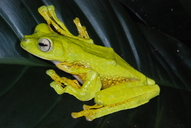|
Rhacophorus nigropalmatus Boulenger, 1895
Wallace's Flying Frog, Wallace’s Treefrog | family: Rhacophoridae subfamily: Rhacophorinae genus: Rhacophorus |
 © 2009 Dr. Peter Janzen (1 of 11)
|
|
|
|
Description Skin is smooth or finely granulated above, coarsely granulated below except smooth on the throat. A broad flap of skin on outer edge of forearm and tarsus, and another is at the heel and above the vent. A narrow flap on the inner edge of the arm is present (Berry 1975). Body color of the adult is shiny green with minute white markings and a couple large white patches on the thighs. The flanks, the inside of the thighs,and the undersurfaces of the body are yellow. The interdigital membranes are jet black at the base. These membranes are yellow and veined with black towards the border. The upper surfaces of toes on to four are yellow. Ventral surface of the head and body is whitish (Berry 1975). Distribution and Habitat Country distribution from AmphibiaWeb's database: Indonesia, Malaysia, Myanmar, Thailand Malaysian region distribution from AmphibiaWeb's database: Sabah, Sarawak
Life History, Abundance, Activity, and Special Behaviors Comments Carotenoids are pigments produced primarily by plants. Animals ingest carotenoids to use in a variety of important ways, especially in producing or modifying coloration. For example in birds, they are the basis of the red pigmentation in the plumage of breeding male house finches and crossbills. Stückler et al. (2022) investigated the role of carotenoids in modulating coloration in Wallace's Flying Frog, Rhacophorus nigropalmatus. This frog exhibits a dramatic ontogenetic shift in coloration from bright red in recently metamorphosed juveniles, to green and brown with extensive white spotting in older juveniles, to vivid green with black and yellow webbing and yellow flanks in adults. In controlled experiments, they showed that dietary carotenoid supplementation was necessary for this species to achieve its natural vivid green adult coloration. Individuals without a source of dietary carotenoids, or reduced carotenoid intake, were blue-green in color. Furthermore, R. nigropalmatus was capable of extensive rapid color changes associated with either the stress of handling or the light regime experienced by the individual frog – but only if they had sufficient carotenoids in the diet. This study broke a lot of new ground, including that the dull adult pigmentation resulting from lack of sufficient carotenoids in early life is apparently not correctible later in life with enhanced carotenoid intake. Given the likely importance of baseline coloration and dynamic color change for crypsis and sexual selection, dietary carotenoids are likely critical to R. nigropalmatus – and this likely applies to many additional species of frogs as well. (Written by Jim McGuire)
References
Berry, P. Y. (1975). The Amphibian Fauna of Peninsular Malaysia. Tropical Press, Kuala Lumpur. Jurgen, F., Richter, C., and Jacob, U. (1988). Atlas of Reptiles and Amphibians for the Terrarium. TFH Publications, Neptune, N.J. Originally submitted by: Sunny Shah and Rachna Tiwari (first posted 2001-11-29) Edited by: Tate Tunstall, Michelle S. Koo (2022-08-15) Species Account Citation: AmphibiaWeb 2022 Rhacophorus nigropalmatus: Wallace's Flying Frog <https://amphibiaweb.org/species/4524> University of California, Berkeley, CA, USA. Accessed Jun 1, 2025.
Feedback or comments about this page.
Citation: AmphibiaWeb. 2025. <https://amphibiaweb.org> University of California, Berkeley, CA, USA. Accessed 1 Jun 2025. AmphibiaWeb's policy on data use. |





 Map of Life
Map of Life